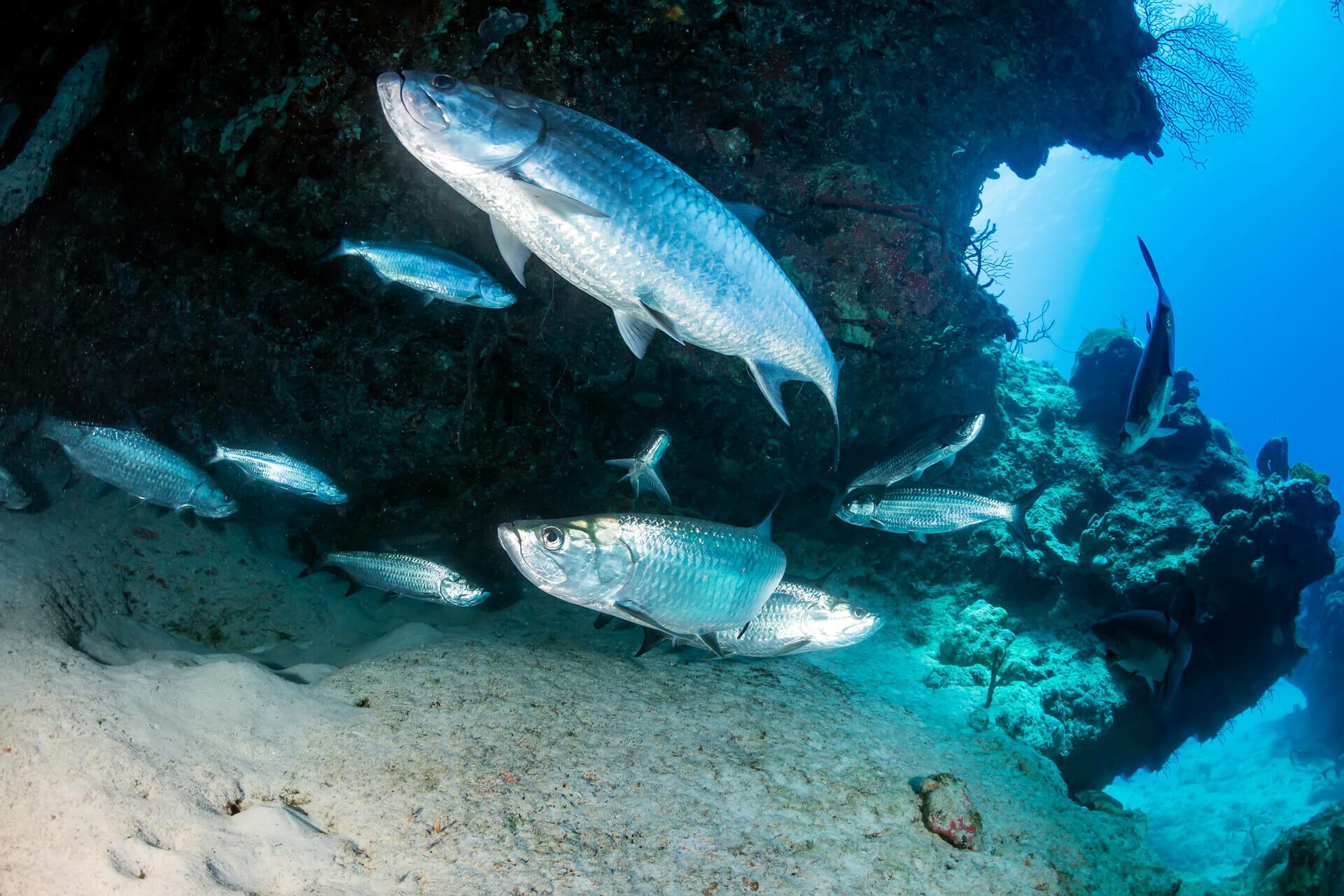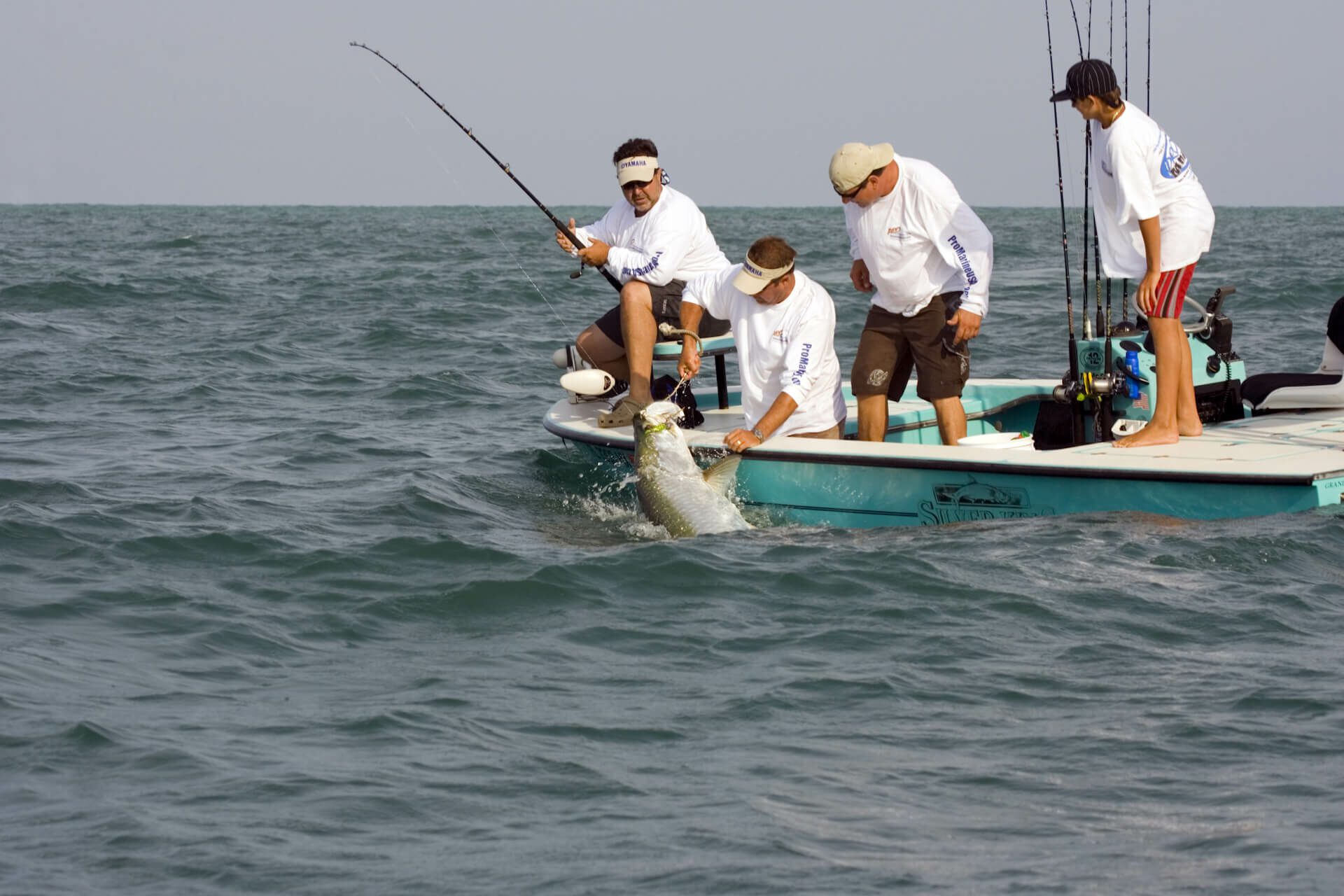Last updated on July 25th, 2023
- What Does Trout Taste Like: Unraveling the Flavor Mysteries - August 2, 2023
- Best Fishing Bibs Tested & Reviewed: Buyer’s Guide - July 19, 2023
- Fishing for Whiskers: Best Bait for Catfish - July 12, 2023
Tarpon are an iconic gamefish, prized by anglers for their size and fight. But have you ever wondered if these powerful creatures can be enjoyed in another way? Can you eat tarpon? Indeed, tarpon can be consumed. Tarpon flesh has a unique flavor that’s mild yet savory with hints of sweetness. With the right recipes and preparation techniques, this delicious fish can become a staple on your dinner table. Read on to learn more about where tarpon live, what they taste like raw or cooked, as well as some mouthwatering recipes to try at home.
Table of Contents:
- Where Do Tarpon Live?
- What Does Tarpon Taste Like?
- Can You Eat Tarpon Raw?
- Recipes for Cooking Tarpon
- Hand Feeding Tarpon
- Conclusion
- FAQs
Where Do Tarpon Live?


Tarpon, a species of large silver-scaled fish, are widely distributed in the Atlantic Ocean from New York to Brazil. Tarpon are found in a broad swath of territory, stretching from New York to Brazil. Tarpon are known for their long migrations and can be found nearshore, inshore, offshore, or even in brackish estuaries.
Tarpon thrive in warm waters between 68°F (20°C) and 86°F (30°C), often congregating near reefs or grass beds to feed on small baitfish. During the day they may move into deeper water but will return to shallow areas at night when they become more active.
Popular Fishing Locations
Tarpon fishing is popular throughout their range from North Carolina to Florida in the United States all the way down through Central America to South America’s east coast countries like Brazil and Venezuela. The most common places anglers target tarpon include bays, flats, beaches, jetties/piers/bridges, mangroves/estuaries and deepwater habitats like channels or passes leading out to open ocean waters.
Every year, tarpon migrate along both coasts of Florida from south to north during the spring months and then back again during the fall months before heading south for wintertime spawning grounds off Mexico’s Yucatan Peninsula or other parts of Central America such as Belize or Panama Bay. According to NOAA Fisheries data analysis reports, adult fish aggregate each year during April-May time frames with peak activity occurring around May 15th annually.
Tarpon, sought-after by many recreational anglers, inhabit the tropical and subtropical waters of our planet. Knowing what tarpon tastes like is important to anglers looking to make their catch into an enjoyable meal.
“Tarpon are a prized catch for anglers. Found in tropical & subtropical waters from New York to Brazil, they migrate along both coasts of Florida every year. Peak activity is around May 15th – so start planning your tarpon fishing trip now.” #tarponfishingClick to Tweet


What Does Tarpon Taste Like?
Tarpon is not the most sought-after fish to eat. If you’re looking for a quality saltwater fish to consume, make sure to check out Amberjack. Nevertheless, Tarpon is edible and has a mild, sweet flavor that is a little reminiscent of swordfish. The challenge is that Tarpon have a lot of bones and some people would characterise their smell as pretty strong and fishy.
For tarpon, the best approach to cooking is to keep it simple – just a light seasoning of salt and pepper should suffice. A pinch of salt and pepper can bring out the natural tastes of tarpon without being overpowering. For a burst of flavor, adding some citrus slices before cooking can help bring out the sweetness of the fish while also providing zesty notes. Grilling or baking are great ways to cook tarpon since these methods help retain moisture while allowing you to control how much heat your food gets exposed too – just make sure not to overcook.
Key Takeaway: Grilling or baking tarpon with a minimal sprinkling of salt and pepper can yield an exquisite taste experience, as the fish has a mild, pleasant flavor. When cooking tarpon, keep it simple – don’t overseason and make sure not to overcook it as this will ruin its delicate flavor. However, if you’re looking for a great tasting saltwater alternative, check out Amberjack.
Can You Eat Tarpon Raw?
Safety Considerations for Eating Raw Fish
Eating raw fish can be dangerous if not done properly. Before consuming raw fish, it is essential to ensure that the product has been frozen at -4°F (-20°C) or below for a minimum of seven days. To ensure safety, it is essential to eliminate any parasites or bacteria by freezing the fish at -4°F (-20°C) for a minimum of seven days. It’s also important to ensure that your fish is fresh and hasn’t been sitting out on ice too long, as this could lead to spoilage. Additionally, it’s best practice to thoroughly clean all surfaces and utensils used when handling raw tarpon before consuming it.
Preparation Tips for Eating Raw Tarpon
Although we don’t recommend it, technically, you can eat raw Tarpon. When preparing tarpon for raw consumption, it’s essential to start with a high-quality product; look for firm flesh with no discoloration or signs of aging. After selecting your tarpon fillet, rinse it off under cold running water before patting dry with paper towels. To remove any remaining scales from the skin side of the fillet, use a sharp knife or scaler tool while holding onto the opposite end firmly with your other hand. Next, use a sashimi blade or parer to cut into thin strips or cubes contingent on the size of the fillet. Finally, place them on an ice tray until ready to serve—this helps keep them fresh and cool.
Key Takeaway: Before consuming raw tarpon, it’s important to ensure that the fish has been frozen for seven days and all surfaces have been cleaned. Preparation involves rinsing off the fillet, removing scales with a sharp knife or scaler tool and slicing into thin stripscubes using either sashimi knives or paring knives.
Recipes for Cooking Tarpon
Tarpon Fishcakes
One of my favorite ways to enjoy a Tarpon every once in a while is turning it into fish cakes – here’s why: Whoever said that cooking is a piece of cake clearly hasn’t tried making fish cakes! But don’t worry, I’m here to share my favorite tarpon recipe and it’s so easy that even a fish out of water can do it! First, fill up a pot with chicken broth and drop your fish inside. Let it simmer for 10 minutes, and voila! Your fish is boneless and ready for the next step.
Now, blend your catch with some veggies, egg, garlic, and spices to create a paste. Roll it out on a floured surface to make fish cakes, and cook them up in a pan or oven. In just a few minutes, you’ll have delicious fish cakes that are sure to make your taste buds swim with joy. So don’t be afraid to dive in and give it a try!
Key Takeaway: Tarpon are not the most delicious fish to process. If however, you want to give it a try – turn them into fish cakes.
Hand Feeding Tarpon


Hand feeding Tarpon is a popular activity among recreational fishermen. It can be done off the dock or from a boat, and it’s an experience that will make you feel like you’ve been transported to another world. Tarpon are found in tropical waters around the world, including the Caribbean Sea, Gulf of Mexico, and Atlantic Ocean. They’re large fish with silver scales and distinctive eyes that bulge out of their heads.
Hand feeding them is an exciting way to get up close and personal with these majestic creatures! When hand feeding Tarpon, small pieces of fish such as sardines or anchovies work best. You’ll want to cut the bait into bite-sized chunks so they don’t choke on it when they try to swallow it whole. Be sure not to overfeed them; too much food can cause digestive issues for these big fish! Also keep your hands away from their mouths – those sharp teeth can do some serious damage if you’re not careful!
Once you have your bait ready, simply toss it near where the Tarpon are swimming and watch as they come up for a snack! The sight of dozens of giant fish fighting each other for scraps is truly awe-inspiring – just remember not to get too close or else they might startle easily.
Conclusion
In conclusion, tarpon can be a delicious and nutritious addition to your diet if prepared correctly. Raw tarpon should not be ingested due to the potential presence of parasites and other contaminants. If you are looking for creative ways to cook up tarpon, there are many recipes online or in cookbooks which can help bring out its delicious flavor. Whether grilled, smoked or baked, Tarpon can make a great meal so don’t forget: Can You Eat Tarpon? The answer is yes.
Join us to learn more about the best fishing tackle, lures and techniques for successful bass and recreational fishing. Discover how you can enjoy a safe tarpon-eating experience with our expert guidance.
FAQs: Are Tarpon Good to Eat?
Are you allowed to eat tarpon?
No, it is not recommended to eat tarpon. Tarpon are a protected species and harvesting them for consumption is illegal in most areas. Consuming tarpon is not recommended due to the presence of mercury in their flesh, which can pose a health risk. Therefore, the best course of action is to release any caught tarpon back into the water unharmed and enjoy recreational fishing without consuming your catch.
Is it illegal to eat tarpon in Florida?
In Florida, it is illegal to harvest or possess tarpon for the purpose of consumption. This includes killing and keeping a tarpon as well as filleting and eating any part of a tarpon caught while fishing. Violators of the law can face significant fines and other penalties, such as imprisonment, for each tarpon harvested or possessed. Therefore, it is not legal to eat tarpon in Florida.
Is tarpon a protected fish?
Tarpon is a protected fish in many areas. In the US, any attempt to keep or possess tarpon without an appropriate permit from the state wildlife agency is illegal. This protection applies both to wild and hatchery-raised tarpon, so anglers must be aware of local regulations before fishing for them. Additionally, some countries have established closed seasons during which no fishing for tarpon may take place. Therefore, it is essential to confirm with the relevant authorities prior to fishing for tarpon in order to adhere to all applicable laws and regulations.
